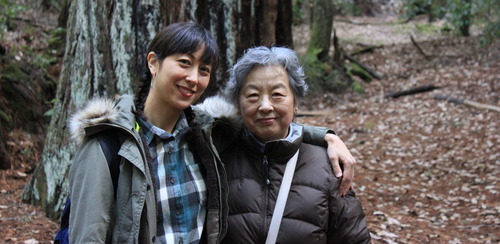BY KATHLEEN OK-SOO RICHARDS

The author and her mother above.
To my mom, clothes were more than just fabric and thread; they quite literally embodied the spirits of the people who made them, which is one reason why she never let me cut off my jeans, even if I had bought them secondhand. “Someone made those,” she’d say. “How would you feel if someone cut what you put time and effort into?”
This sentiment extended to other inanimate objects as well — especially those made in Korea. It’s why a sad-looking ceramic mug or vase found at a yard sale or thrift store would come home with us. She didn’t want that Korean object to feel unwanted or unloved. She’d polish it up and place it on a shelf, with the other misfit knickknacks. Perhaps it was her experience living through war and being a refugee that made her appreciate things and not take anything for granted.
Subconsciously, I adopted this same attitude. I considered my stuffed animals my children; it was my duty to love them and take care of them and make sure they never felt alone. When I looked outside my bedroom window and saw dark skies approaching, I’d gather them all around on my bed, tucking them under the blanket and making sure they all felt safe and secure and that none of them felt less important or left out. Plants on the deck and cats in the neighborhood received similar treatment. On those rare scorching-hot days in Berkeley, I’d imagine the plants saying “Oh thank you, thank you!” as I poured water over them.
Throughout the decades, my mother slowly got rid of much of her old clothes. She lost her desire to keep material possessions, and those items she kept — no matter how well-made — revealed they, too, had a shelf life: They’d get eaten by moths, develop mold, or get too tired-looking to wear.
But I can’t seem to get rid of any of my mother’s clothes — even when a fine cotton blouse recently ripped clear in half. To me, the clothes are more than just cotton, wool, and silk. They are pieces of my mother, like her second skin, which she has lived in and shed over the years. They hold memories — of weddings and birthday parties and summers spent at my grandparents’ house — ones that will linger long after she is gone. Woven into their fabric are her hopes and dreams and aspirations — of having a successful career, a happy family, and a life as a free, independent woman.
This is an excerpt from a full length piece that will be featured in an anthology by Asian Women United. For inquiries and submissions, please contact motherofallstories@gmail.com.
